









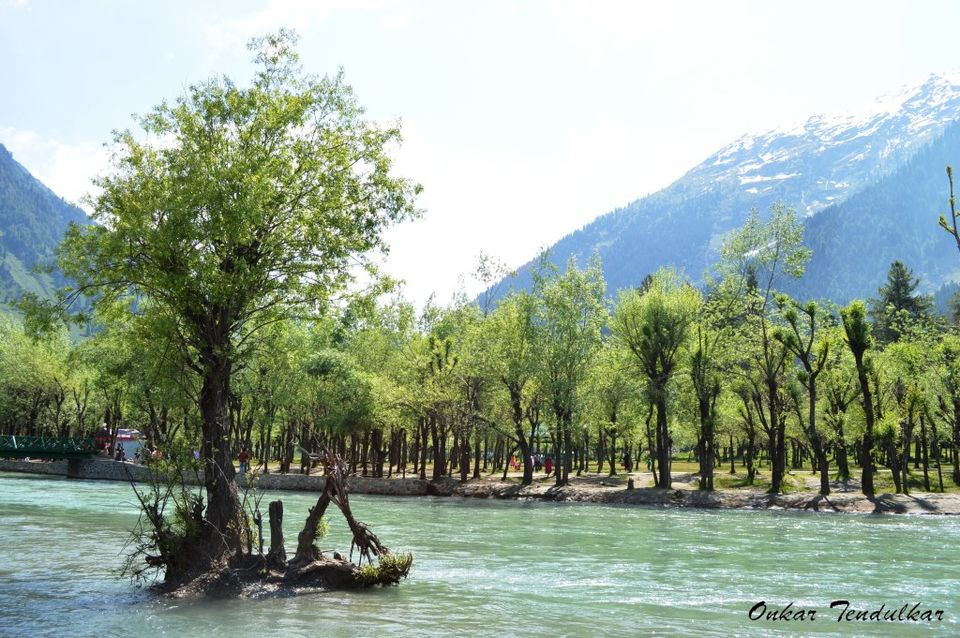













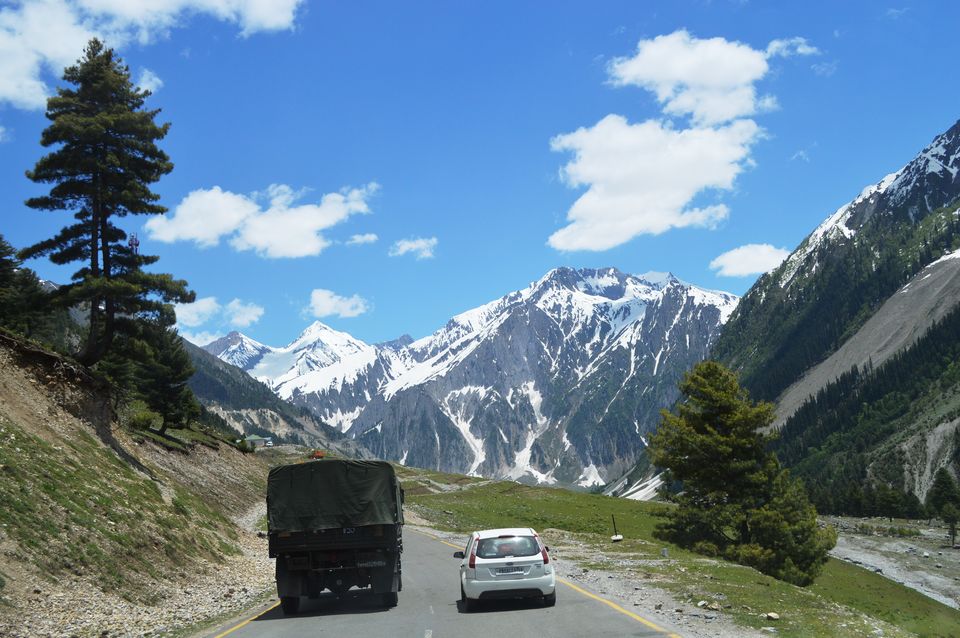







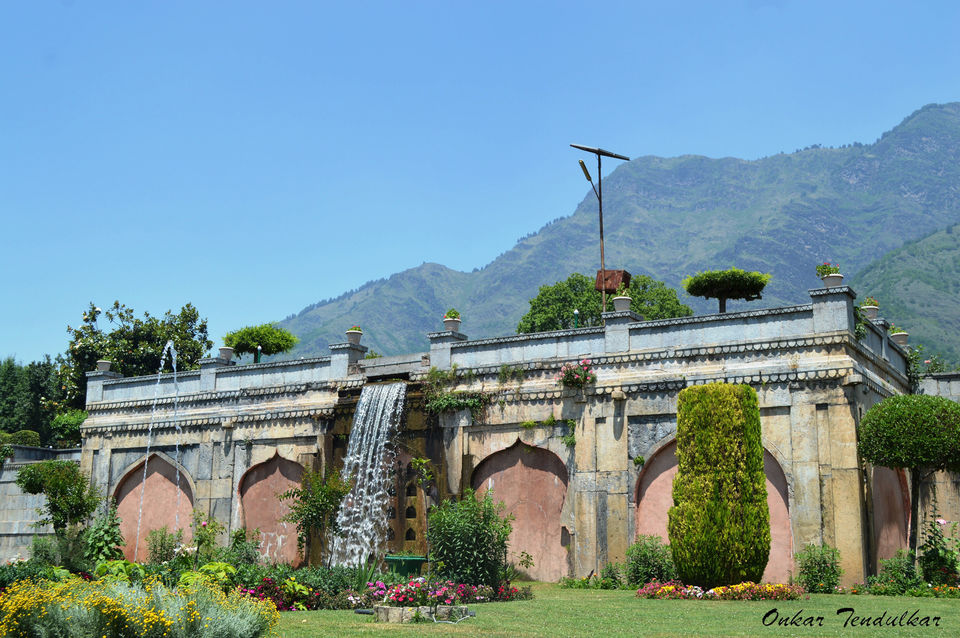




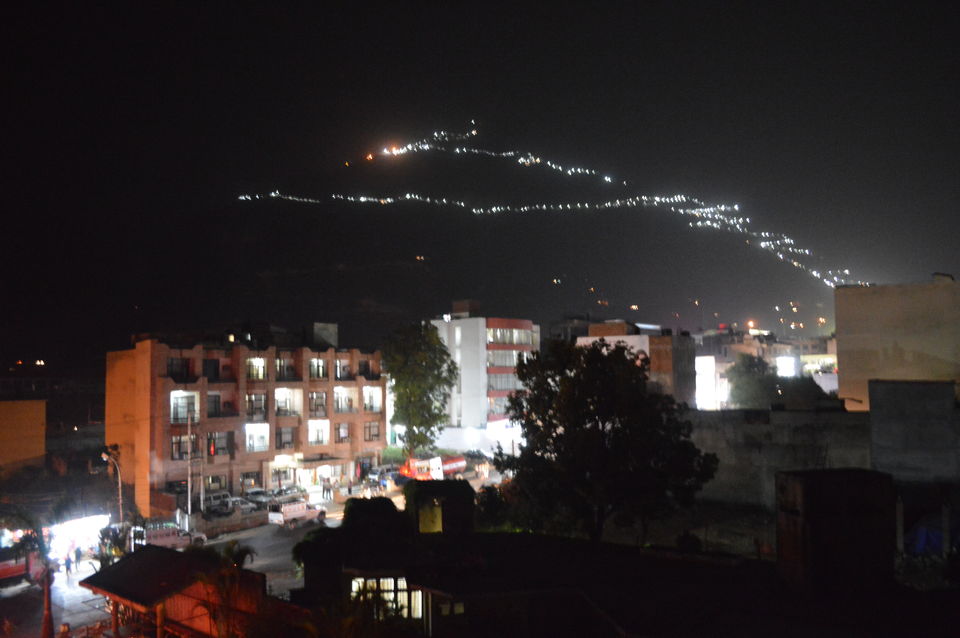
Glimpses of Kashmir- June 2014
Mumbai> Jammu> Pahalgam> Bijbehera> Awantipora> Pampore> Srinagar> Gulmarg> Srinagar> Sonamarg> Srinagar> Katra> Jammu> Mumbai
As always, going to Kashmir too was an eleventh hour plan for me and this time I had my folks as well for company. My folks are the kinds who like to travel hassle free, luxuriously and the types who don’t mind paying extra cost for their comfort. Having said this, I need not mention that they booked with a Pune based travel company for the trip- something that I hate to do! Nevertheless I had no option this time…
Much has already been written about the so called paradise on earth- Jammu and Kashmir in so many articles and travelogues, so I am going to try to keep this post short. :D
Day1: On the morning of 8th June, we took a flight to Delhi and then waited for the night train for Jammu. Having decided to travel at the end moment, we couldn’t manage to get train bookings to Jammu from Mumbai. Thanks to the holiday season, railways had announced a holiday special train between Delhi and Jammu. Our travel company managed to get us 3 berths in that train just in time. Everything fell in place! Day2: Morning around 8 o clock, we reached Jammu Tawi railway station. Since we were the first ones to arrive, (rest of the group was coming by train including the tour manager and would reach Jammu in the afternoon) we booked ourselves a prepaid taxi to our hotel- Jammu Ashok. We took short nap and till then other group members arrived in hotel. After lunch and introduction, we left for some sightseeing in Jammu city. First place we went to was ‘Bahu fort’ situated on the banks of Tawi river- but on a hilltop. Bahu fort is a simple but impressive structure from outside. According to Wikipedia, this fort is approx. 3000 year old- but was refurbished by Dogra rulers to its present state in 18th century. Except from outside, this fort is nothing like a fort. Today all that’s left inside is a garden and couple of temples- the famous of them being- Bawe wali Mataji ka Mandir. Most of the stuff including wallet and camera is not allowed inside. Although lose money can be carried inside. Just a few minutes’ walk from the fort is Bagh- E- Bahu garden. There is not much information available as to when was this beautiful garden laid. This garden is designed and laid on the concept of Mughal gardens. Bagh- E- bahu has many characteristics of a Mughal garden i.e. stepped gardens, symmetry, fountains, water streams etc. This garden has two entry points one at the top and one at the bottom (since the garden is sloped) Hence it is advised that you enter through the upper entrance and descend down rather than climbing the steps upwards. This garden also has an aquarium (near its upper entrance) which has a separate entry fee of Rs. 10 (in 2014). Even though it is called the largest underground aquarium in the country, its quite small and houses mostly small species of fishes. The aquarium itself is shaped like a huge fish which is entered through its mouth. Our next destination was the famous ‘Raghunath mandir’ in the bustling Jammu market. The temple is heavily fortified and hence NO cameras, cellphones, wallets, bags are allowed inside the temple. Front facade of the temple is quite attractive. Once you enter inside the main gate of the temple, there are many many other temples in this complex. Beware of touts once inside! Few minutes’ walk from Raghunath temple is another temple called- Ranbireshwar temple. The bazar outside Raghunath temple is worth a stroll. It is filled with shops of dry fruits, sweets and woollens. I also spotted a chat shop diagonally opposite Raghunath temple. I made sure to eat Golgappas there before heading back to hotel. Another place worth visit while in Jammu is the Amar Mahal palace. This charming palace of erstwhile Dogra rulers is now converted into a museum. Sadly it was closed that day and we couldn’t have a look inside. If you find museums boring, at least go and have a look at the palace’s stunning exterior which is designed in European style.



Day3:Today early morning we started for Pahalgam. Even though the distance is approximately 290 km, it takes almost 12-13 hours to cover the journey in the minibus we were in. Cars/ taxis may take a couple of hours lesser. The highway from Jammu to Pahalgam is quite wide in the plains of Jammu but they get narrower as we enter the hills. Udhampur town is the first well known place we cross after approx 70 km. Udhampur town has a large military presence as it has the Northern command headquarters of Indian army as well as base support unit of Indian airforce. Krimchi group of temples is a beautiful temple complex located in Udhampur believed to be built in 11th-12th century. Interestingly, the architecture of these temples shows Greek influence. These temples can be approached through a bypass few kilometres before entering into Udhampur city- and from that point, these temples are at a distance of 14 km.As soon as we cross Udhampur town, the Tawi river which we had left behind in Jammu, again starts following us for a few kilometres and again goes away at a town called ‘Kud’. Kud is famous for ‘Patisha’ a sweet dish which is very similar to the Sonpapdi we get in the mainland- but this one has a lot of ghee- tasty nevertheless. After Kud, we were stuck in traffic jam because, the favourite picnic place of Jammuites- Patnitop; was only couple of kilometres ahead. Patnitop is comparatively a colder place for the Garmi se pareshan Jammuwalas. We halted our bus for sometimes to take pictures of surrounding valleys and started our journey again. Patnitop has a few resorts and few places of interest for the ones who are interested in staying here. Frankly, I didn’t find Patnitop very attractive- may be because we travelled there in June, it didn’t feel like a hill station at all!12 kilometers from Patnitop, we halted for lunch at a place called ‘Batote’. As our tourist guide told us, we should not expect many decent eateries ahead of this place. Batote felt like an interesting village. It has mosques as well as temples. Its interesting to observe demographics of the places while heading from Jammu to Kashmir valley. Jammu town and surrounding areas have a Hindu majority. Going further to Udhampur, Hindus and Muslims form 75%- 25% of population approximately and Batote has an equal percentage of population of both the communities. After the sumptuous meal, we headed further. Near the town of Chandrakote, another great river starts racing with us- the Chenab. Now the mountains around seem to be getting taller and mightier as compared to the hills of Patnitop. The great Chenab cuts through the mountain and valleys and plays hide and seek with us- sometimes appearing on our left and sometimes on the right. ‘Ramban’ is another big town we crossed on our way. At Ramban, we saw a lot of people wearing the traditional clothes of Kashmiri muslims, buying vegetables and daily wares in the bazars along the highway. After Ramban, the road doesn’t cross many big towns till Banihal which is approximately at a distance of 40 km. At Banihal, one can see the engineering marvel- the Kashmir valley railway tracks laid on our left side. One can spot the newly built Banihal station and if lucky you may even see a train plying on the route. These trains appear very different than the normal Indian trains because of the bullet train like front of this train.After a short tea break at Banihal, we were reaching Anantnag town any moment. Verinag- on the outskirts of Anantnag is famous for an extremely stunning Mughal garden built by emperor Jehangir in 1620 A.D. It consists of lawns and a spring which is one of the main sources of Jhelum River. This garden with its Chinar trees turning red and orange in autumn; makes the garden look very picturesque. After crossing through Anantnag town and taking the Pahalgam road, comes a place called Mattan. A 1.5 km small road from Mattan leads to ‘Martand Sun temple’. This temple was built in 8th century by king Lalitaditya Muktapida of Karkota dynasty- dedicated to the ‘Sun God’. Today the temple is in ruins as it was destroyed completely by Islamic ruler Sikander Butshikan.Further 42 km of road from Anantnag to Pahalgam is straight without any twists and turns and can be reached within an hour. Now the Lidder river- a tributary of Jhelum gives us company till Pahalgam. We couldn’t help but halt our minibus a little before Pahalgam on the banks of Lidder to take pictures. Lidder river in many ways reminds one of Beas river in Manali. The same clean white water, same pebbles scattered around, same snow clad mountains around and the same icy cold water.In less than half an hour we reached Pahalgam and settled in our hotel located on what looked like the main street of Pahalgam on Chandanwadi road. It was almost 7 pm in the evening and the climate was very cold for a summer evening. We had our food early and slept off covering ourselves with thick quilts.Day4:This morning, we had breakfast of garma garam Aloo ka parantha and left for sightseeing of Pahalgam. First we headed to Betaab valley- named so due to the Hindi film of the same name being shot here.It is important for travellers to note that using private vehicles and outside vehicles (other than Pahalgam number plate) are not allowed in Pahalgam for sightseeing. You need to leave the vehicles in hotel and hire a local taxi from taxi union for sightseeing who have fixed rates for sightseeing depending upon how many places you want to cover- rates ranging from rs.2000 to rs.4000+ (rates in 2014)Betaab valley is not very far from the main town. In fact you are already there by the time you settle down in the taxi. Betaab valley is basically a ticketed park along the Lidder river. The sparkling water of Lidder river, the perfectly mowed grass, and the beautiful pine trees make Betaab valley look extremely gorgeous. Betaab valley is fairly clean (may be thanks to the all-state ban on polythene bags). Best thing about Betaab valley is that whether u click yourself at the river or at the bridge or click random trees and mountains, every angle is going to give you results as stunning as the other. After having a walk through this riverbank park, we headed towards gate. At the gate are a lot of small kids with rabbits and lambs trying to make quick bucks for letting us pose with their cute pets. Jhalmudi and ‘ Bambaiyya’ Bhelpuri vendors outside the gate make this place a perfect Indian picnic spot.Now we were heading to Chandanwadi further on the same road. For Chandanwadi, the road starts sloping upwards, and from there, one can see mind-blowing bird’s eye view of the whole Betaab valley park. Road to Chandanwadi is one of the best roads one would ever get to travel in India. Curvy roads, melting glaciers, a lot of big- small streams coming out of the melting snow, sun lit mountains- everything you see here is out of this world. This road is a photographer’s delight! Guaranteed!Chandanwadi is basically a snow point where u can play in snow even in summers. You can hire gum boots at the many stalls here for reasonable price and leave ur footwear at the same stall. A lot of stalls here also serve hot Maggie! Itni thand me Maggie khane ka maza hi kuch aur hai!Chandanwadi is also the starting point of the holy Amarnath yatra. After playing and falling a lot of times on the slippery snow, we headed back. Aru valley is another place 12km from Pahalgam, famous for its meadows. Its also a base camp for treks to a lot of lakes and glaciers in surrounding areas. Baisaran- also called as mini Switzerland is one of the top rated attractions in Pahalgam. For Baisaran, one needs to take a pony ride from Pahalgam. Its at an hour’s distance by pony. The narrow rocky road on the way looks risky but the ponies are probably used to it. Charges for pony approx. Rs. 1500 (in 2014)Other than these main attractions, there is a Mamleshwar temple dedicated to Shiva and some small parks created by tourism department along Lidder River in Pahalgam town.










Later that day, we left for Srinagar- a distance of approx. 90 km. This journey takes the same route we took while coming from Anantnag for few kilometres and then takes a short cut bypassing Anantnag town through well-kept Kashmiri villages and apple orchards. This internal road after a journey of 45-50 minutes comes out on NH-1A near town of Bijbehera. Bijbehera city is famous for the factories of bats. Everyone even little interested in cricket knows about these famous bats from Kashmir. You can stop your vehicle at any of these shops and maybe catch a live demonstration and shop for bats if interested. This time it’s the Jhelum River that gives us company along the way. After approx. 20 km from Bijbehera, we arrive at Avantipora town. Awantipora is famous for the ruins of Awantiswamin temple (dedicated to Vishnu) and Awantishwar temple (dedicated to Shiva)- both of which are in ruins today. These 8th century temples were built by Awantivarman- the king of Utpala dynasty. The Avantiswamin temple is in fractionally better state than the other and one can observe interesting sculptures of Vishnu, Ganga- Jamuna and the king himself among others. Both these temples are now protected by Archaeological survey of India. Entry fee Rs.5 for residents of India, Pakistan, Sri Lanka, Maldives, Bhutan, Nepal, Bangladesh, Afghanistan, Thailand and Myanmar. For others, the entry fee is Rs. 100.Another 13km ahead from Avantipora is Pampore- famous for the saffron fields. We did some quick shopping for saffron and dry fruits at a shop there and sipped a cup of Kahwa- the Kashmiri tea prepared using saffron and almonds. October is the right season if one wants to see the flowers blooming. When we visited, the fields were dry.


Saffron fields continue for a couple of kilometers more and then start the outskirt suburbs of the state capital- Srinagar. Slowly you start seeing the heavy army presence in the city- army personnel standing on the rooftops of all the houses with riffles in their hands and army vehicles plying here and there.After entering the city, we took another half an hour to reach the Dal lake because of the traffic. We alighted near the Ghat no. 9 of Dal lake and we along with our luggage got into Shikaras. The first look of Dal lake was out of this world. Dal lake seems like another Venice- a city inside a city- a floating city. There are people selling kesar, handicrafts, jewellery and everything else imaginable in their shikaras. There are floating schools, floating markets, floating post office, floating photo studios, floating Maggie sellers and what not! Already awed at the first glimpse of Dal lake, I was super excited for the next 2 nights stay we were going to experience in the houseboat. Meanwhile we reached our houseboat’s base. From the base, we climbed the steps to the verandah of the houseboat and whoa! My jaw dropped when I saw the exquisite drawing room of the houseboat through its glass doors. I just couldn’t wait to enter the houseboat. Exquisite wooden furniture made of almond tree, neat wooden carvings on the door frames and ceilings, antique showpieces, beautiful chandeliers and a carpet matching to all this- I was going crazy!A big houseboat like ours normally comprises of a common drawing room, a common dining area and a passage which has a number of bedrooms along its length. Our houseboat had 4 bedrooms. I changed and came back to the verandah to take some evening snaps of the laid back life on Dal lake. It was past 7:30 pm, the shikaras were heading back and the houseboats were slowly being lit up- creating beautiful reflection in the water. We could also see the lit up Shankaracharya temple far away on the hilltop. With such a beautiful view being offered, nobody wished to dine in the closed dining room of the houseboat. So our tour manager got the food arranged on the deck in front of houseboat. It was definitely a memorable experience to dine in open with such beautiful surroundings on a chilly night like that…



Day5:Early morning today, we left for Gulmarg. Gulmarg is about 50 km from Srinagar but takes approx. 2 hours to reach. Most of the road to Gulmarg is wide and open cutting through the urban and rural areas at times. We halted at a place called Tangamarg to hire gum boots and again went further ahead. Reaching Gulmarg, we have to park our vehicle in the parking lot and cross the further distance till the base of ropeway either by walking or by a pony- for a distance little over 15 mins. Decide you choice in advance as once you get down from your vehicle, many pony wallahs will pounce on you, hold your hand and almost force you to ride on their pony. Avoid having a brawl with the local pony wallahs. As for us, the distance was hardly anything, so we preferred to walk. This road goes along the beautiful Gulmarg golf course- one of the highest golf courses in the world. Reaching the base point of ropeway, our tour manager went to get the tickets. (Gondola tickets can be booked either online or on the spot. In tourist season, like June, Gulmarg is flooded with travellers and there are long queues and unthinkable rush to buy tickets at the ticket windows. So, either try to book the tickets online or appoint a local travel agency to do the same for you. Standing and waiting in the queue for your turn is a waste of time and may spoil your mood to even go for the ropeway ride. We had to wait even for our tour manager to get tickets for us for approx. an hour)Gulmarg Gondola is in two levels- first level Gondola takes you from base to Gulmarg- Khilanmarg. And second level takes you to near Mouth Apharwat. If you want to go in June- July and also want to play in snow, then going only to first level is waste for you as the snow on the first level melts in April and May and there is no snow here in June- July. While on 2nd level, you will get plenty of snow to play in during any season. The tickets to second level ropeway are few and get full really fast. To avoid disappointment, consult a local travel agency in advance to help you get tickets for the second level as well. From first level, there are ponies which take you to Khilanmarg snow point and glacier- a ride of approx. half an hour. While we were sitting on the first level, suddenly a real bad storm storm appeared out of nowhere and winds started blowing at crazy speed. We all ran away and took shelter inside the Gondola station. Meanwhile the intensity of storm increased and all the roof tops and tin shades became part of history within no time. With extreme low visibility and raid of dust, finally it started raining and soon it turned into a hailstorm. Everyone rushed in the queue to Gondola to go back down to the base. While on the way down, we saw that the base was still sunny and they had no clue what had happened on top! Such is Gulmarg- extremely unreliable climate!After lunch, we headed back to Srinagar.Reaching Srinagar early, we did a 45 minutes shikara ride in the Dal lake. It takes one to floating Nehru park, the floating vegetable farms and markets. A must do while in Kashmir! Alternately, some shikaras also take you further to Char Chinar Island which has 4 chinar trees standing in the middle of lake. Some people prefer to take pictures of them in the Kashmiri attire on this island. After the heavy dinner, we retired in our houseboats. Hell tired; we didn’t take much time to fall asleep.




Day 6:Today was the turn to go on excursion to Sonamarg. Sonamarg falls on the NH-1D i.e. Srinagar-Leh highway passing through Kargil. It is at a distance of 80 km from Srinagar hence expect a journey of 3 hours one way! While leaving, we also checked out of houseboat and shifted to a hotel- few kilometres from Dal Lake in an area called Jawahar Nagar (since apparently all the hotels close to Dal lake tourist area were full)From a place called Ganderbal, beautiful Sind River travels along our side right till we reach Sonamarg. (This Sind river which is a tributary of Jhelum is not to be mistaken with the great Sindhu/Indus river which flows from Tibet to Pakistan via Ladakh)We had tea and snacks on the way at a place called Kangan on the banks of Sindh and started our journey again. Such small halts in any bus journey are much needed for some relaxation from the rigid journey of buses which I never like. Road to Sonamarg is quite a scenic one from the start. Shepherds herding their sheep and lambs, (and often blocking the entire road), pretty hamlets on the banks of Sind and mighty snow-capped mountains is how one can summarize this beautiful road. Reaching Sonamarg, we halted for a while at the JKTDC tourist hotel while our manager negotiated with the local cabbies for the sightseeing. In a while, our cab came to pick us up and we headed for a drive to Baltal- approx. 15 km or so from Sonamarg. Baltal is another starting point of Sri Amarnath yatra (alternate to Chandanwari in Pahalgam. The route from Baltal is very short but very difficult and one can reach the destination in a day or two while the road from Chandanwari is long but easier and takes several days to a week to reach the holy Amarnath cave)Drive to Baltal is even more beautiful than what we had seen till now. Going to Baltal is like going up close to the mighty mountains and trying to absorb as much of the scenic marvels around as you can. Similar to Chandanwari in Pahalgam, there are a few spots near Baltal, where one can find snow to play even in month of June. Needless to say, there are bhelwalas, chaiwallas and Magiewalas here as well….On the way is are a few points- one of which is a picnic spot called ‘Fishing point’- as told to us by our Ladakhi cabbie. The park has a picnic lawn, a small food shop, a small lake for boating and a small waterfall. But it was sad to see people littering around and plastic wrappers in the water stream leading from the waterfall.Just in front of the entry of the park, small time rafting activities are conducted on Sind River, however its nothing close to the water rafting in Rishikesh on the Ganges.Coming back to the JKTDC banquet hall, we had our lunch. The main thing which Sonamarg is famous for is the pony ride to Thajiwas glacier point. However, Thajiwas glaciers are just the Sonamarg’s version of Chandanwari glaciers of Pahalgam- plain basin full of snow, surrounded by tall icy cold mountains from all sides. If you have already enjoyed enough at Chandanwari, in my opinion, you can give this place a miss- if you find the rates charged by ponies exorbitant!Coming back to Srinagar, we straight headed to Hazratbal mosque on west bank of Dal Lake. Hazratbal is the holiest mosque in Kashmir and houses hair of beard of Prophet Mohammad. It was Friday that day- the so called bada din (big day) for the locals and hence us being Hindus were denied entry to the inner sanctum. However we can always enter the mosque’s external areas and the open space adjoining Dal Lake used for prayers by the locals. Its worth noticing that this mosque is one of very few mosques in Kashmir built in dome and minaret style. Almost all other mosques in Kashmir have typically Kashmiri architecture which resembles a lot to Buddhist pagodastyle of oriental countries. From here, we drove straight to the hotel and discharged for the day.

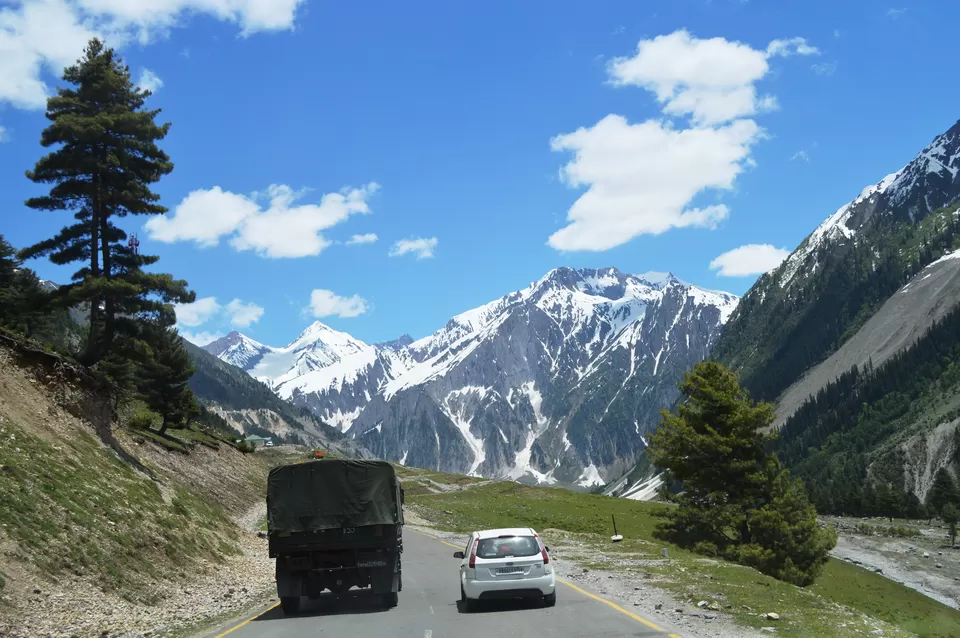




Day 7:Unlike earlier couple of days, today we all got up aaraamsey, coz today we just had to do the local sightseeing of Srinagar. Very first, we headed to the Shankaracharya hill to visit the Shiva temple. The temple is situated at a height of 1000 feet above the plains and offers stunning view of the whole city. Sadly, the hill being a military area, cameras and mobile phones have to be left in the car itself. This temple is said to be belonging to 200 BC, but the present temple is built only in 9th century. Adi Shankaracharya is said to have visited this place several times for meditation- hence the name. The temple is approached from the base by climbing a lot of steps (frankly I didn’t count how many) but should take you approx. 10-15 minutes if you are young, fit and fine. Next to the temple, there is also a small cave temple where Adi shankaracharya meditated. Make sure to follow queue if you want to go inside the sanctum of the cave- as its very small, suffocating and a stampede here could easily prove to be fatal. Now it was the turn to visit the famous Mughal gardens of Srinagar built by Shah Jahan and Jahangir in 17th century. First one we visited was, Chashme shahi garden. Chashma means spring. This garden got its name because it is built around a natural spring which is said to give out the purest form of water which cures some ailments like coughing etc. My long time coughing did disappear soon after- don’t know whether for this water or coz of the beautiful nature of Kashmir. Soon followed a story of Pt. Nehru refusing to drink any other water than from this spring during his tenure in Delhi as first Prime minister of India, Truth or rumour? God knows.We Indians hear of this phenomenon, and we don’t run to the spring with our plastic bottles- quite impossible no? Soon there was a long queue to fill the water bottles from the spring of icy chilled water. Chashme shahi is a small and sweet garden unlike the other gardens that followed later. Shalimar garden is still attractive but Nishat garden directly facing the Dal lake; is extremely ill maintained. Locals washing tiffin in the fountains and streams, tourists sitting on the pretty waterfalls created in the garden; as if they were visiting a water park, wrappers of chips flowing with the water all over the garden etc summed up our short 5 minutes visit to the garden. One guy travelling with us did try to alarm the guards in the garden about these happenings, but in vain! Tourists and locals both seemed alike- equally irresponsible!Newly established Indira Gandhi Tulip garden is also in close vicinity of Chashme shahi garden. But this garden is open only in March and April when the Tulips bloom. These tulip flowers of different colours last barely for a month or so- hence plan your trip accordingly if visiting this garden is a must in your to do list. If you have extra time, and already not bored and can visit more gardens, do visit the Parimahal terraced garden behind Chashme shahi garden at a height and Badambari garden somewhere in the main city.We came back to our hotel for lunch and then caught some afternoon sleep and then again left for visiting some more landmarks of the city on our own without the group.Jama masjid located in Nowhatta area of Old city is a gem of a structure built by Sultan Sikander in 1400 A.D. Once we enter through the gate of mosque, we find ourselves in the middle of a massive courtyard with mosque’s colonnade surrounding us on all sides. There are four pagoda like roofs on large arched wall frames on 4 cardinal directions. In the centre is a small ablution fountain. Photography inside the mosque is mostly allowed. Beautiful tall wooden pillars running in the colonnade and the roofing of wooden joists supported above them form the main characteristics of interior of the mosque. This extremely stunning gigantic mosque can accommodate 1,00,000 people at a time at its peak. If you are an architecture lover, DO NOT MISS THIS PLACE!Next place we visited was the Khanqah of Shah- E- Hamadan- also known as Khanqahi moula- in the old city on the banks of Jhelum river. This was built by Persian sufi poet- saint called Shah Hamadani and his followers. This is probably one of the most beautiful buildings you will ever see in your life! Its almost square shaped in plan and topped with Pagoda roof. The original building here was built in 14th century- but being entirely made of wood, it fell prey to massive fire twice. The current structure we see here is built in 18th century. Right from the frontal arches, the Islamic motifs on them, the wooden roof and the gutters and intricately carved wooden fascia boards- each and everything about this mosque is equally marvellous. Its wasteful for me to try to describe the beauty of this structure here, I will rather let the pictures attached in this post do rest of the talking! The caretakers sitting there did allow me even to click the interior of the mosque for a ‘suggested donation’. Do not forget to take a stroll all around the mosque before leaving.As for the mosque trip i.e. from hotel to Jama mosque and from there to Shah Hamadan and then dropping at Dal Lake, we just asked a local auto guy and he cost us approx. 350rs including the waiting. Today was our last night in Srinagar, hence we thought of doing some light shopping around Dal lake before heading to hotel.

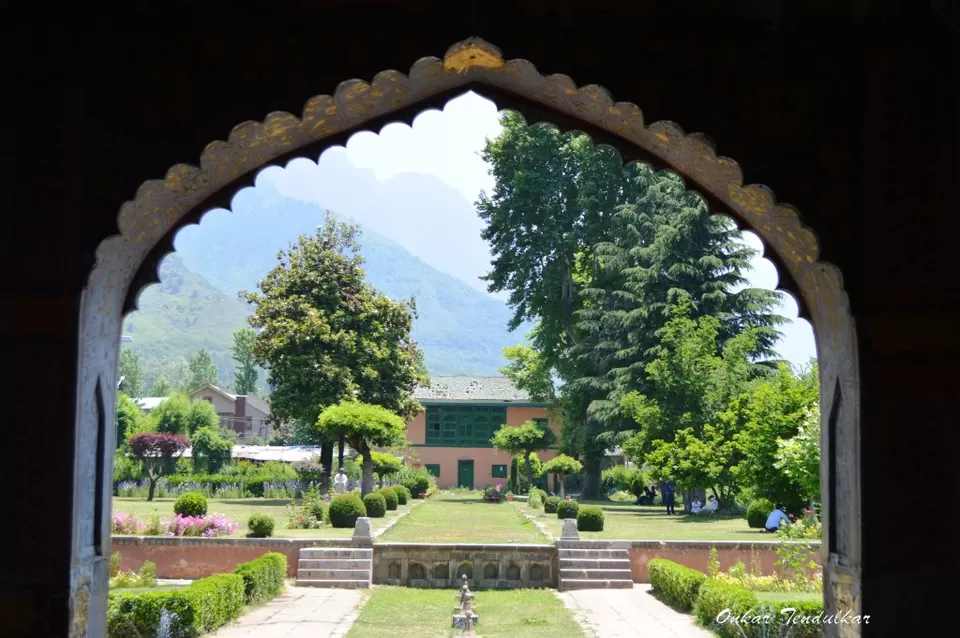






Day 8:Today was going to be a really really reallllly long journey- back to Katra (Vaishnodevi) near Jammu from Srinagar- which was going to consume almost 12 hours.After a sleepy, tiring and back breaking journey, we reached Katra and checked in into a very nice hotel in Katra market. Katra has infinite number of hotels, eateries, dry fruit shops, chaat shops and what not! ….. and soon started, what was the last thing I needed and expected that time. All of a sudden I had diarrhoea and couldn’t move even bit from my place i.e. the hotel washroom. I had heard it from so many people earlier that ‘agar vaishno ma se bulawa nahi aya hoga toh aisa kuch zaroor hoga ki aap vaishnodevi ja nahi paogey’. At the end of it, I actually couldn’t help but believe this. Sadly I had to spend that night in hotel room itself despite having a strong wish to climb the holy mountain, while rest of my folks and group members went ahead for the pilgrimage. Day 9: With a pledge and promise to myself to return back to Vaishnodevi sometime soon, we caught the evening train to Delhi and then further flight to Mumbai the next day!
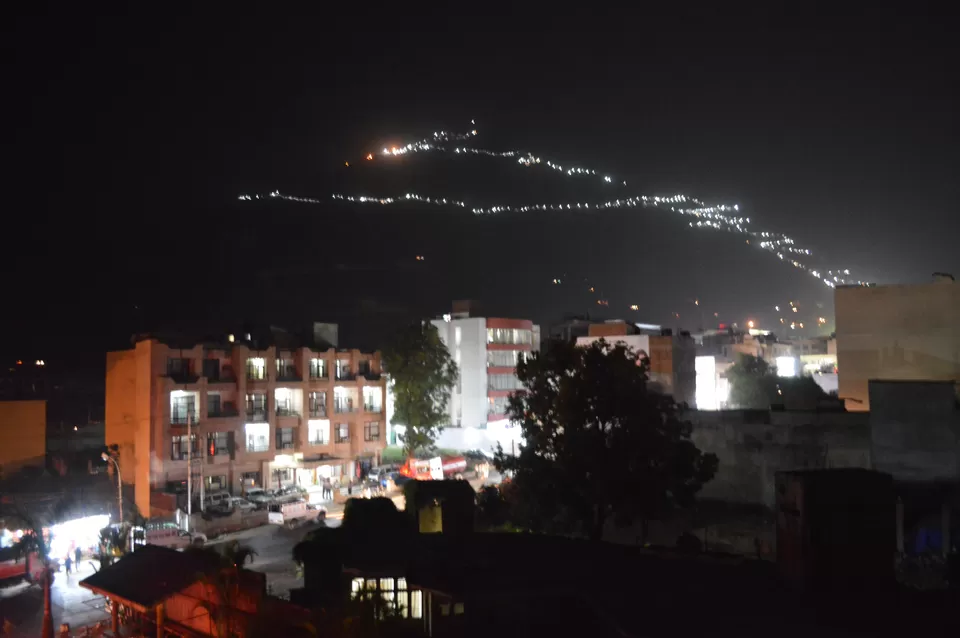
Frequent Searches Leading To This Page:-
top kashmir honeymoon packages, distance between gulmarg and srinagar , gulmarg top hill destination for couple , kashmir tour packages for skiing and trekking , best local food of kashmir

